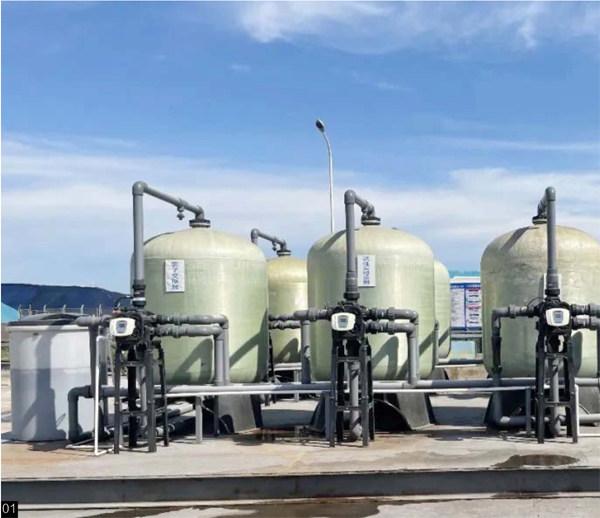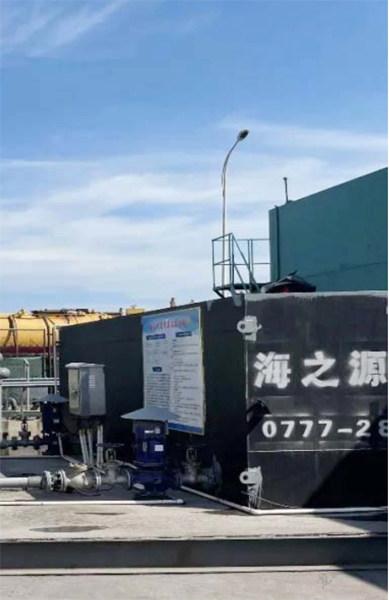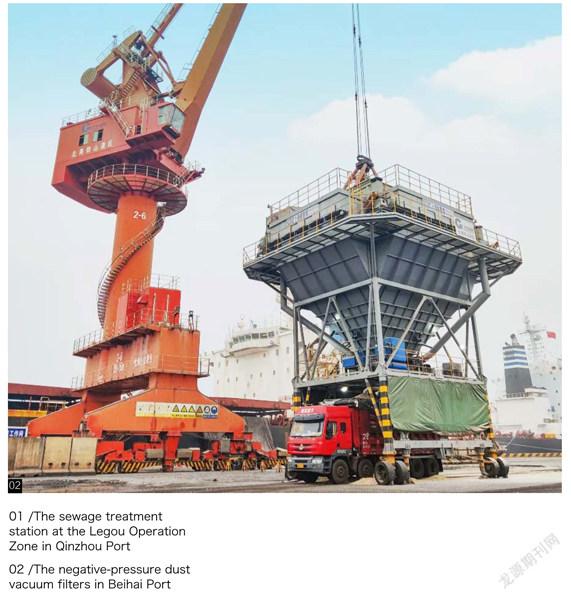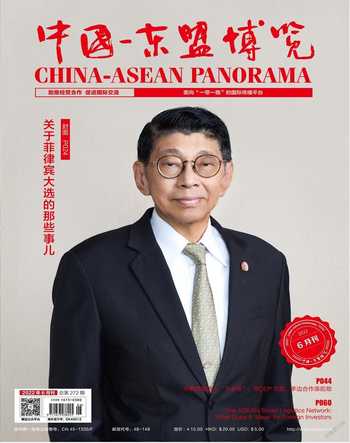Low-Carbon Beibu Gulf Port: A Stroke of Green on the Deep-Blue Dream
2022-06-15ZhaoYaliXieZongming
Zhao Yali Xie Zongming



As a beep from the charge station sounded, a red container truck started its engine, marking the completion of the vehicle’s battery replacement. At the Beibu Gulf Port, the first intelligent electric container vehicle charging station passed its test run. This is merely a glance at Beibu Gulf Port’s green development.
In recent years, Guangxi Beibu Gulf International Port Group (the Group) actively practice President Xi Jinping’s thought of ecological civilization and speed up the construction of the Four First-Class international hub port, and seize the opportunity of a new round of scientific and industrial revolution, for which it sees good results in building a “green and carbon-free” port.
Promoting the green port construction
At the first Beibu Gulf Green Port Development Forum, organized by the Beibu Gulf Port Group in August 2021, the Declaration on the Development of Beibu Gulf Green Port was released. The Group has set the sustainable development goals of building the Beibu Gulf Port into an advanced port in China and a first-class port in the world.
In the past few years, the Group supplemented its weak links and enhanced the construction and management of environmental facilities, achieving significant results in green port construction. The Group started the 2021 Port Area Environment Improvement Initiative. The improvements include new facilities for sewage treatment, windproof dust suppression nets, negative-pressure dust vacuum filters, hazardous waste storage yards, and a new long-term management system, realizing the full cover of open-air bulk cargo. The number of days with good air quality in the port area maintain above 99%. The port sees great improvements in landscaping, solid and hazardous waste storage capacity, and rain & wastewater collecting ability and reuse rate. In general, the port-scape is significantly improved.
In Beihai Port Area, three negative pressure dust vacuum filters are put into operation, and the designed dedusting capacity of each collector is 800 tons per hour. The devices not only create a clean environment for dry bulk cargo but also improve the loading and unloading efficiency, being a handy tool that showcases how technology facilitates green development.
One thing worth mentioning is that the Group has made huge efforts in mangrove reforestation, investing a total of 68 million yuan in the reforestation project. By August 2021, 257 mu of mangrove is restored, and another 505 mu is planted at new locations to make up for the rest of the areas taken.
Also, the Group sets up a sewage treatment station in the Legou Operation Zone, meeting 100% of the zone’s sewage treatment requirements. The professionalization rate of grain loading and unloading reaches 68% in Fangchenggang Port Area, and more than 60% of the coals and ores are transported by conveyor belts. The pilot test of China’s first independently-designed intelligent electric vehicle charging station in the Fangchenggang Port Area shows Beibu Gulf Port’s green vision to the people.
Turning waste into wealth
On April 8, 2022, the integrated waste management plant of Beigang New Materials utilized its two sets of direct-redox rotary kilns to dispose of the last batch of hazardous waste, weighing 32 tons, from Jigongshan Mountain, Laibin, Guangxi, completing the disposal task in advance. Altogether, the company handled 170,000 tons of waste from Jigongshan Mountain, saving a disposal cost of about 100 million yuan.
In the pandemic era, Beigang New Materials also used the waste management plant to dispose of 23 tons of medical waste in March 2022, significantly easing the stress on medical storage in Beihai City, Guangxi, earning the compliments from Beihai, and demonstrating the company’s social benefits.
Tieshan Port Area is the main field of Beihai City’s industrial development. In recent years, the green chemical industry, advanced metal materials, advanced equipment manufacture, high-end glass, photovoltaic materials, advanced paper-making, and new energy are the five major industrial clusters in the area that keep on developing. Inevitably, enterprises create all kinds of waste, which has become an intricate issue.
The Yufeng Group of Beibu Gulf Port Group has started the construction of the Tieshan Port Environmental Solid Waste Recycling Complex project in 2019, thus upgrading itself from the traditional industry to the green industry. After the project was put into operation in 2020, the complex has been devouring the waste from companies like Beigang New Materials and producing high-quality binding materials recycled from solid waste. The complex provides the fundamental solution for industrial waste disposal, especially the disposal of smelting waste and other industrial wastes in the Tieshan Port Industrial Park in Beihai and the neighboring areas.
Jiang Jiufang, Executive Director and CEO of Yufeng Group, introduced that since August 2020, the recycling project in Tieshan Port Area has produced 2 million tons of recycled inorganic binding materials. Judging from proportion, the facility has recycled more than 30 tons of smelting waste of steel and more than 20 tons of fly ash and FGD gypsum. Currently, the project has the annual capacity to recycle about 1.7 million tons of waste produced by the nearby companies, with an annual production value of 560 million yuan, contributing 14 million yuan of tax. The recycled products are sold to the Guangdong-Hong Kong-Macao Greater Bay Area, Southeast Asia, and even Africa, additionally creating 20,000 TEUs of cargo throughput for the port.
Optimizing structure to become a carbon-free port
The Beibu Gulf Port seizes the opportunities like the energy revolution and digital transformation by promoting the development philosophy of “green and environmental, energy-saving and low carbon emission” in every process, from production and operation to construction and management, and puts more efforts into energy conservation and carbon emission cuts with multiple measures.
As the requirement for high-quality and environmental development continues to increase, the Beibu Gulf Port also adjusts its energy consumption structure accordingly. In 2017, the Beibu Gulf Port Group and China Southern Power Grid jointly launched the shore power construction for the intelligent port. Two years later, the port’s shore power was able to provide energy for the high voltage systems on ships. By 2021, more than 100 units of mobile new energy equipment were put into use in each port area of Beibu Gulf Port, and shore power coverage has reached 87.5% and 61.9% respectively for container berths and production berths 50,000-ton-level and above.
In addition, in building the green multi-modal combined transportation, the Group actively promotes transportation restructuring, the sea-rail combined transport volume and transport integration were thus skyrocketing. Meanwhile, the Group actively respond to the carbon peaking and carbon neutrality goals and speed up the “carbon-free port” building. In the future, Beibu Gulf Port Group will continue to focus on rail-river and river-sea combined transport and develop the multi-modal combined transportation that takes the port as the hub and the single-bill system as the core. The Group will also enhance the sharing of railway system information and optimize the dispatch platform for information on green collection and distribution.
By 2025, the proportion of green transportation used on bulk cargo transport in the sub-ports under the Beibu Gulf Port is expected to reach 80%, and clean energy consumption will be 60% of the total energy consumption. The bulk cargo wharves will meet the 3-star green port standard, container wharves, 4-star, and the new automatic container wharves, 5-star.
Beibu Gulf Port Group plays as the guardian of the Gulf’s environment, balancing environmental protection and economic benefits and turning the “clean water and lush mountains” into “gold mines” that aid the port’s development, adding “a stroke of refreshing green” to the high-quality development of the port.
